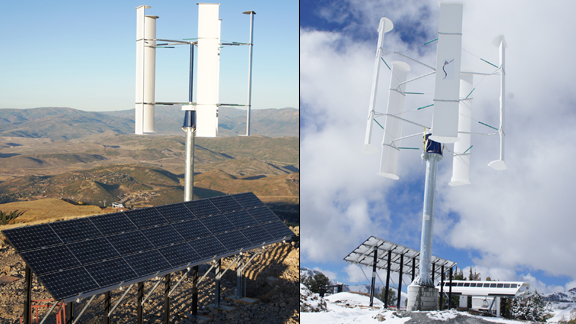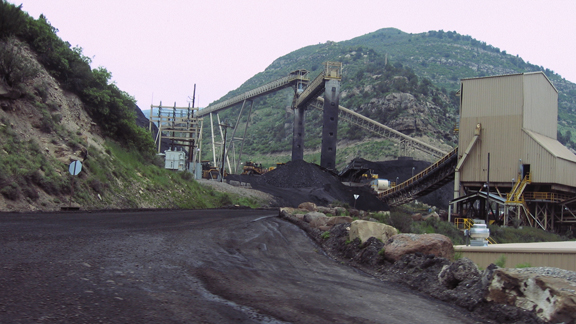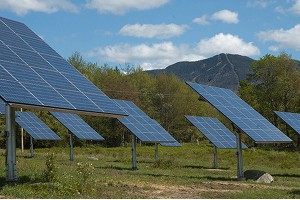U.S. ski resorts tap renewable energy sources to combat climate change
By Jesse Huffman | ESPN Action Sports
 Courtesy photoSummer
and winter alternate views of Park City's wind and solar installation,
which is located at the top of their Silverlode chairlift.
Courtesy photoSummer
and winter alternate views of Park City's wind and solar installation,
which is located at the top of their Silverlode chairlift.
As the volatility of the 2011-12 season made clear, the stake ski
resort's have in resolving climate change is a big one. Over the past
three years, resorts like Bolton, Burke, Jiminy Peak and Grouse Mountain have installed wind turbines, while others have pursued efficiency updates,
in an effort to responsibly produce, and reduce, the power and heat
involved in swinging chairs and heating lodges all winter long. Now,
four more areas, from local ski hills in the Northeast to major resorts
in the Rockies, have installed or invested in renewable power sources
ranging from solar to biomass to coalmine methane.
Smuggler's Notch closed early this winter after a spring meltdown saw the highest March temperatures in Vermont's history. The same solar energy that drove skiers and riders batty as it took away their snow is now being put to use by an array of 35 solar trackers, which collectively produce 205,000 kWh per year -- around five percent of Smuggler's total electrical use. The array provides enough juice for most of the resort's Village Lodge.
Dan Maxon, Smuggler's Notch Solar Installation Project Manager, toured me through the installation on a recent morning, when the GPS-enabled trackers, manufactured by a Vermont company called ALLEarth Renewables, were tilted east to catch the a.m. sun.
"We believe it is important not only for ski resorts, but for all energy users to take some responsibility for their energy consumption," Maxon told me. "There was a good confluence of energy and desire that made this project come together -- we'd been looking at various renewable projects for six-seven years, but couldn't pull them off. This one we could."
The array would normally have cost a million dollars to install, but
Smuggler's engaged in an innovative leasing program from AllEarth, and
in five years it will have the option to buy the equipment outright at
a reduced price. Smuggler's is adding this solar project to existing
efforts to outfit new condominium units with solar hot water heaters.
As for further renewable projects, Maxon says that Smuggler's will be focusing on efficiency at the resort and in the snow making system next. I asked Maxon if he thought that ski resort's high-elevation locations made them especially suitable to industrial-sized wind generation, like the type at Bolton Valley or Jiminy Peak. He pointed out that while ski resort ridgelines could be prime locations for wind power, many ski resorts, including Smuggler's, lease land from the State, making such projects difficult.
Over at Mt. Abram in Maine, renewable heat has literally risen from the ashes. A lighting strike set fire to the ski resort's main lodge in the summer of 2011, burning the building to the ground.
Taking the occasion to revisit the resort's dependence on fossil fuels, Mt. Abram built their new lodge with a wood pellet boiler. Stoked by dry, highly-pressurized wood pellets from sustainably-harvested sources right in the state, the "Energy Box" system provides plenty of warmth for the lodge. Building off that momentum, Mt. Abrams updated the heating in their rental shop and top patrol shack with pellet heaters as well.
"Switching from No. 2 heating oil to a carbon-neutral, locally-sourced system was an easy decision based on our current goals as a ski area" says Erin Bragg, Mt. Abram's Director of Sustainability. "The move was also pushed to the forefront of our 'greening' time line due to the destruction of our oil boiler in the fire."
The base lodge project, which offsets the use of more than 12,00 gallons of No. 2 heating oil per year, helped win the resort a National Ski Area Association Golden Eagle Award for Environmental Excellence this year. Hancock believes that "all ski areas have a strong self preservation interest in promoting projects that support colder, snowier winters."
 In the case of solar, says Hancock, many ski areas have available
land but it's likely to be facing north, and thus not in the direct
path of the sun. Mt. Abram, like Smugglers, has enough south-facing
acreage to make solar a real option.
In the case of solar, says Hancock, many ski areas have available
land but it's likely to be facing north, and thus not in the direct
path of the sun. Mt. Abram, like Smugglers, has enough south-facing
acreage to make solar a real option.
"Mt. Abram has engineered and is fully permitted for a two-acre solar array specified to generate more electricity annually than we consume," says Hancock. He adds that the resort is the final phases of financing and hopes to have the installation in place before the 2012 ski season.
Hancock sees pressure from customers, not just warming winters, as a driver that will push resorts to do more to lower their impact.
"You don't venture out with kids and grandparents in zero degree windy weather if you don't love the outdoors and care greatly about the planet," says Hancock. "As more ski areas take a more serious approach to their environmental footprint, I believe a greater environmental stewardship will be an ante to stay in business."
Across the divide in the Rockies, Park City Mountain Resort has recently installed a Falcon 12kW vertical axis wind turbine at the top of their Silverlode chairlift. Paired with a solar panel, the installation generates 30,000 kW hours of electricity annually, around three times the amount of an average home. Park City also included an informational kiosk that will let the public see the power being generated in real time.
"Our goal is for our guests to see a turbine and solar array installation up close and hopefully encourage them to install wind or solar at their home or business," says Brent Giles, Chief Sustainability Officer of Powdr Corp, Park City's parent company.
"We live, work and recreate in a mountain setting and we want to continue this lifestyle for years to come," says Giles. "Therefore we have adopted a policy to reduce emissions generated by our operations."
Large-scale renewable installations aren't really an option at Park City, says Giles. Instead, the resort purchases wind power renewable energy credits that offset 100 percent of their electricity usage, which averages 14 million kWh's annually.
 Auden SchendlerElk Creek mine in Colorado, where Aspen's coal mine methane-to-electricity project will be developed.
In Colorado, Aspen
Ski Company is taking a leading role in developing an innovative form
of clean energy from coalmine methane. The practice of venting methane
from coalmines to prevent underground explosions has turned into a
climate change bottleneck with 20 times more warming potential than
CO2, coalmine methane contributed ten percent of the all U.S.
greenhouse gas emissions in 2010, according to the EPA.
Auden SchendlerElk Creek mine in Colorado, where Aspen's coal mine methane-to-electricity project will be developed.
In Colorado, Aspen
Ski Company is taking a leading role in developing an innovative form
of clean energy from coalmine methane. The practice of venting methane
from coalmines to prevent underground explosions has turned into a
climate change bottleneck with 20 times more warming potential than
CO2, coalmine methane contributed ten percent of the all U.S.
greenhouse gas emissions in 2010, according to the EPA.
Aspen is the capital investor in a new project at Elk Creek Mine that uses waste methane to power a dynamo and generate electricity, downgrading the methane to CO2 and at the same time. The project is a first of its scale in the United States, and helped net the resort a National Ski Area Association Golden Eagle Award for Environmental Excellence this year.
"We've been looking for a large scale clean energy project for over a decade and we finally found one," says Auden Schendler, Aspen Vice President of Sustainability.
Schendler expects the 3 megawatt project to go online around September, and says that in a matter of month it will make approximately the same amount of electricity that Aspen uses annually, around 25 million kilowatt hours. "Because we're destroying methane in the process," adds Schendler, "this is equivalent to triple offsetting our carbon footprint each year."
Schendler believes that industrial scale, on-site power generation wasn't feasible for Aspen, and isn't necessarily the solution for other resorts.
"We're trying to develop a huge amount of clean power, we're not trying to do something gimmicky," says Schendler. "We don't need to shoehorn clean power into inappropriate places like most ski resorts, there are plenty of good projects to develop, they don't happen to be at ski resorts. The atmosphere doesn't care if the power gets used on site -- scale is everything when it comes to solving climate change."
Which isn't to say that Schendler and Aspen don't support renewable energy development by ski resorts. The opposite in fact: "It's important, so that when these resorts go to Washington to ask for an aggressive climate policy they have a leg to stand on and some credibility," says Schendler. "We need to walk before we can talk."
Smuggler's Notch closed early this winter after a spring meltdown saw the highest March temperatures in Vermont's history. The same solar energy that drove skiers and riders batty as it took away their snow is now being put to use by an array of 35 solar trackers, which collectively produce 205,000 kWh per year -- around five percent of Smuggler's total electrical use. The array provides enough juice for most of the resort's Village Lodge.
Dan Maxon, Smuggler's Notch Solar Installation Project Manager, toured me through the installation on a recent morning, when the GPS-enabled trackers, manufactured by a Vermont company called ALLEarth Renewables, were tilted east to catch the a.m. sun.
"We believe it is important not only for ski resorts, but for all energy users to take some responsibility for their energy consumption," Maxon told me. "There was a good confluence of energy and desire that made this project come together -- we'd been looking at various renewable projects for six-seven years, but couldn't pull them off. This one we could."
[+] Enlarge

Courtesy photoSmuggler's solar tracker array with Madonna Mountain in the background.
As for further renewable projects, Maxon says that Smuggler's will be focusing on efficiency at the resort and in the snow making system next. I asked Maxon if he thought that ski resort's high-elevation locations made them especially suitable to industrial-sized wind generation, like the type at Bolton Valley or Jiminy Peak. He pointed out that while ski resort ridgelines could be prime locations for wind power, many ski resorts, including Smuggler's, lease land from the State, making such projects difficult.
Over at Mt. Abram in Maine, renewable heat has literally risen from the ashes. A lighting strike set fire to the ski resort's main lodge in the summer of 2011, burning the building to the ground.
Taking the occasion to revisit the resort's dependence on fossil fuels, Mt. Abram built their new lodge with a wood pellet boiler. Stoked by dry, highly-pressurized wood pellets from sustainably-harvested sources right in the state, the "Energy Box" system provides plenty of warmth for the lodge. Building off that momentum, Mt. Abrams updated the heating in their rental shop and top patrol shack with pellet heaters as well.
"Switching from No. 2 heating oil to a carbon-neutral, locally-sourced system was an easy decision based on our current goals as a ski area" says Erin Bragg, Mt. Abram's Director of Sustainability. "The move was also pushed to the forefront of our 'greening' time line due to the destruction of our oil boiler in the fire."
The base lodge project, which offsets the use of more than 12,00 gallons of No. 2 heating oil per year, helped win the resort a National Ski Area Association Golden Eagle Award for Environmental Excellence this year. Hancock believes that "all ski areas have a strong self preservation interest in promoting projects that support colder, snowier winters."

Courtesy photo Mt. Abram's GM standing with the resort's Golden Eagle award in front of their wood-pellet boiler.
"Mt. Abram has engineered and is fully permitted for a two-acre solar array specified to generate more electricity annually than we consume," says Hancock. He adds that the resort is the final phases of financing and hopes to have the installation in place before the 2012 ski season.
Hancock sees pressure from customers, not just warming winters, as a driver that will push resorts to do more to lower their impact.
"You don't venture out with kids and grandparents in zero degree windy weather if you don't love the outdoors and care greatly about the planet," says Hancock. "As more ski areas take a more serious approach to their environmental footprint, I believe a greater environmental stewardship will be an ante to stay in business."
Across the divide in the Rockies, Park City Mountain Resort has recently installed a Falcon 12kW vertical axis wind turbine at the top of their Silverlode chairlift. Paired with a solar panel, the installation generates 30,000 kW hours of electricity annually, around three times the amount of an average home. Park City also included an informational kiosk that will let the public see the power being generated in real time.
"Our goal is for our guests to see a turbine and solar array installation up close and hopefully encourage them to install wind or solar at their home or business," says Brent Giles, Chief Sustainability Officer of Powdr Corp, Park City's parent company.
"We live, work and recreate in a mountain setting and we want to continue this lifestyle for years to come," says Giles. "Therefore we have adopted a policy to reduce emissions generated by our operations."
Large-scale renewable installations aren't really an option at Park City, says Giles. Instead, the resort purchases wind power renewable energy credits that offset 100 percent of their electricity usage, which averages 14 million kWh's annually.
 Auden SchendlerElk Creek mine in Colorado, where Aspen's coal mine methane-to-electricity project will be developed.
Auden SchendlerElk Creek mine in Colorado, where Aspen's coal mine methane-to-electricity project will be developed. Aspen is the capital investor in a new project at Elk Creek Mine that uses waste methane to power a dynamo and generate electricity, downgrading the methane to CO2 and at the same time. The project is a first of its scale in the United States, and helped net the resort a National Ski Area Association Golden Eagle Award for Environmental Excellence this year.
"We've been looking for a large scale clean energy project for over a decade and we finally found one," says Auden Schendler, Aspen Vice President of Sustainability.
Schendler expects the 3 megawatt project to go online around September, and says that in a matter of month it will make approximately the same amount of electricity that Aspen uses annually, around 25 million kilowatt hours. "Because we're destroying methane in the process," adds Schendler, "this is equivalent to triple offsetting our carbon footprint each year."
Schendler believes that industrial scale, on-site power generation wasn't feasible for Aspen, and isn't necessarily the solution for other resorts.
"We're trying to develop a huge amount of clean power, we're not trying to do something gimmicky," says Schendler. "We don't need to shoehorn clean power into inappropriate places like most ski resorts, there are plenty of good projects to develop, they don't happen to be at ski resorts. The atmosphere doesn't care if the power gets used on site -- scale is everything when it comes to solving climate change."
Which isn't to say that Schendler and Aspen don't support renewable energy development by ski resorts. The opposite in fact: "It's important, so that when these resorts go to Washington to ask for an aggressive climate policy they have a leg to stand on and some credibility," says Schendler. "We need to walk before we can talk."

Fantastic! I like this type of information which provides me lot of information about Argentina Ski Resorts..
ReplyDeleteArgentina Ski Resorts